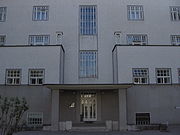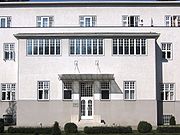
Sanatorium Purkersdorf
Encyclopedia
The Sanatorium Purkersdorf was built as a sanatorium
in Purkersdorf
, Wien-Umgebung
, Lower Austria
. It was built in 1904-05 by the architect Josef Hoffmann
for the industrialist Victor Zuckerkandl
and is an example of the style of the Viennese Secession in architecture.
in 1903. It was acquired as a "mineral spa together with cure-park." Since the 19th Century a mineral spring bubbled on the property. The original furnishing were made by the Wiener Werkstätte
with which the architect Hoffmann was involved. The ownership and management of the sanatorium were lost in the course of the Aryanization
of 1938.
 The sanitarium was more of a hotel than hospital and turned into a social and artistic venue of Viennese society. Among the treatments were mineral baths, physical therapies, therapeutic massages and physiotherapy. Convalescence cases and mental illnesses were especially treated in the upper classes. Through silence, light and air, and the rationality of the facility with ornament reduced to a minimum, cures of the new illnesses such as nervousness
The sanitarium was more of a hotel than hospital and turned into a social and artistic venue of Viennese society. Among the treatments were mineral baths, physical therapies, therapeutic massages and physiotherapy. Convalescence cases and mental illnesses were especially treated in the upper classes. Through silence, light and air, and the rationality of the facility with ornament reduced to a minimum, cures of the new illnesses such as nervousness
, and hysteria
were sought. Also provided were reading rooms, a playroom for card games, table tennis, billiard and music-rooms for the entertainment of the guests.
In 1926, against the will of Josef Hoffmann, the architect Leopold Bauer heightened the building with another floor, which impaired the original artistic conception.
 After the death Victor Zuckerkandls in 1927 the sanitarium was inherited to his nephews and nieces. From 1930, a son-in-law continued the business with little success. Trude Zuckerkandl tried in 1938 to restore the ailing business. Before an economic recuperation, Austria's Anschluss
After the death Victor Zuckerkandls in 1927 the sanitarium was inherited to his nephews and nieces. From 1930, a son-in-law continued the business with little success. Trude Zuckerkandl tried in 1938 to restore the ailing business. Before an economic recuperation, Austria's Anschluss
took place and in March 1938 was the Aryanization
. Towards the end of World War II
, the building served as a military hospital. In 1945, it was requisitioned by the Russian occupying forces.

's "Alma – A Show biz ans Ende" about the life of the Alma Mahler
-Werfel was filmed there. The necessary interior renovation was finally carried out in the year 2003 and it is now used as a senior care home.
Sanatorium
A sanatorium is a medical facility for long-term illness, most typically associated with treatment of tuberculosis before antibiotics...
in Purkersdorf
Purkersdorf
Purkersdorf is a municipality in the district of Wien-Umgebung in Lower Austria, Austria. The Sandstein-Wienerwald natural park, a part of the Vienna Woods, is situated on its territory....
, Wien-Umgebung
Wien-Umgebung
Bezirk Wien-Umgebung is a district of the state of Lower Austria in Austria. The district comprises four non-contiguous districts on the outer fringes of Vienna: these are Klosterneuburg and Gerasdorf to the north of the city, Schwechat to its south-east and Purkersdorf on Vienna's western...
, Lower Austria
Lower Austria
Lower Austria is the northeasternmost state of the nine states in Austria. The capital of Lower Austria since 1986 is Sankt Pölten, the most recently designated capital town in Austria. The capital of Lower Austria had formerly been Vienna, even though Vienna is not officially part of Lower Austria...
. It was built in 1904-05 by the architect Josef Hoffmann
Josef Hoffmann
Josef Hoffmann was an Austrian architect and designer of consumer goods.- Biography :...
for the industrialist Victor Zuckerkandl
Victor Zuckerkandl
Viktor Zuckerkandl was a Jewish-Austrian musicologist. His doctorate was granted in 1927 from Vienna University, and conducted freelance throughout the decade of the 1920s. He was a critic for Berlin newspapers from 1927–1933 and taught theory and appreciation courses in Vienna from 1934-1938...
and is an example of the style of the Viennese Secession in architecture.
Sanatorium
Zuckerkandl, the general director of the Silesian Iron Work of Gliwice, purchased the property at the city border of ViennaVienna
Vienna is the capital and largest city of the Republic of Austria and one of the nine states of Austria. Vienna is Austria's primary city, with a population of about 1.723 million , and is by far the largest city in Austria, as well as its cultural, economic, and political centre...
in 1903. It was acquired as a "mineral spa together with cure-park." Since the 19th Century a mineral spring bubbled on the property. The original furnishing were made by the Wiener Werkstätte
Wiener Werkstätte
Established in 1903, the Wiener Werkstätte was a production community of visual artists. The workshop brought together architects, artists and designers whose first commitment was to design art which would be accessible to everyone...
with which the architect Hoffmann was involved. The ownership and management of the sanatorium were lost in the course of the Aryanization
Aryanization
Aryanization is a term coined during Nazism referring to the forced expulsion of so-called "non-Aryans", mainly Jews, from business life in Nazi Germany and the territories it controlled....
of 1938.

Neurosis
Neurosis is a class of functional mental disorders involving distress but neither delusions nor hallucinations, whereby behavior is not outside socially acceptable norms. It is also known as psychoneurosis or neurotic disorder, and thus those suffering from it are said to be neurotic...
, and hysteria
Hysteria
Hysteria, in its colloquial use, describes unmanageable emotional excesses. People who are "hysterical" often lose self-control due to an overwhelming fear that may be caused by multiple events in one's past that involved some sort of severe conflict; the fear can be centered on a body part, or,...
were sought. Also provided were reading rooms, a playroom for card games, table tennis, billiard and music-rooms for the entertainment of the guests.
In 1926, against the will of Josef Hoffmann, the architect Leopold Bauer heightened the building with another floor, which impaired the original artistic conception.

Anschluss
The Anschluss , also known as the ', was the occupation and annexation of Austria into Nazi Germany in 1938....
took place and in March 1938 was the Aryanization
Aryanization
Aryanization is a term coined during Nazism referring to the forced expulsion of so-called "non-Aryans", mainly Jews, from business life in Nazi Germany and the territories it controlled....
. Towards the end of World War II
World War II
World War II, or the Second World War , was a global conflict lasting from 1939 to 1945, involving most of the world's nations—including all of the great powers—eventually forming two opposing military alliances: the Allies and the Axis...
, the building served as a military hospital. In 1945, it was requisitioned by the Russian occupying forces.
Hospital
The Protestant church acquired the building 1952 and rebuilt it as hospital. A part of the facility was used as nursing home. The old pavilions had to be rebuilt because of dilapidation. The business was discontinued in the year 1975. The buildings and park remained long unused and fell into disrepair.
Restoration
In 1995 an external renovation took place, whereby the upper floor added by Leopold Bauer was removed and the original appearance was restored. On the inside cultural festivities took place and in the years 1996 to 2001 Paulus MankerPaulus Manker
Paulus Manker is an Austrian film director and actor, as well as an author and screenplay writer.Manker is considered one of the most maverick German-speaking actors, and polarizes public opinion like scarcely no other...
's "Alma – A Show biz ans Ende" about the life of the Alma Mahler
Alma Mahler
Alma Maria Mahler Gropius Werfel was a Viennese-born socialite well known in her youth for her beauty and vivacity. She became the wife, successively, of composer Gustav Mahler, architect Walter Gropius, and novelist Franz Werfel, as well as the consort of several other prominent men...
-Werfel was filmed there. The necessary interior renovation was finally carried out in the year 2003 and it is now used as a senior care home.

